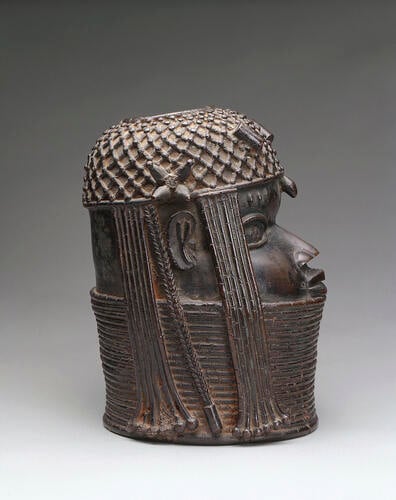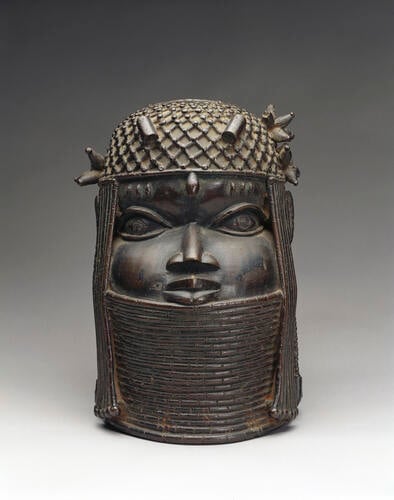-
1 of 253523 objects
Bronze head c.1650
Bronze, iron | 30.0 x 24.0 x 24.0 cm (whole object) | RCIN 72544
-
A Benin bronze head of an oba or king, cylindrical in form, with a circular hole at the top. Wearing a lattice-pattern cap of woven coral beads and with further strands of coral beads suspended on either side of the face. Two larger beads stand in high relief on the front of the cap, and a small bead hangs from the centre of the headdress in the centre of the forehead. The neck is bound with numerous necklaces up to the mouth. The eyes are iron inserts.
From the fourteenth century, each new king or oba of Benin began his reign by creating a shrine to his predecessor. Among the Edo peoples of Benin, the head represents the character and destiny of the individual, and freestanding heads like this one were placed on the shrines as symbols of the qualities and leadership of the previous ruler. Together with carved tusks, staffs and other artefacts, they served as the focal point for a living monarch's communication with his ancestor. This practice was a powerful reminder of the legitimacy and longevity of the ruling dynasty.
In common with other bronze heads of this type, the coral regalia worn by this oba is more prominent than his facial features. Royal control of coral supplies, which were obtained via coastal trade with Europe, made them an ostentatious symbol of wealth and influence. The circular hole at the top of the head would probably have supported an ivory tusk carved with significant events from the oba's reign.
Provenance
Presented to Queen Elizabeth II by General Yakubu Gowon, Head of the Federal Military Government of Nigeria, during his State Visit to the United Kingdom, 12-15 June 1973.
The head dates from c.1650. It would have stood on a shrine in the palace of the oba of Benin until it was seized during the British Punitive Expedition of 1897. The bronze was most likely brought to Britain by an officer from the Expedition, where it later entered the art market. It was eventually bought, probably between 1946 and 1957, for the Nigerian National Museum, where it remained until 1973. -
Creator(s)
(nationality)(nationality)Acquirer(s)
-
Medium and techniques
Bronze, iron
Measurements
30.0 x 24.0 x 24.0 cm (whole object)

